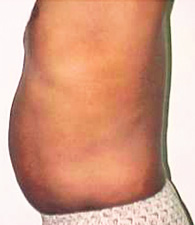Consultant Plastic Surgeon Dr. Thushan Beneragama has a firm ‘not possible’ for anyone who has ever harboured the fantasy of a quick session of liposuction as a cure for their obesity.
The surgery is meant to sculpt the contours of your body (hence it’s alternate title of ‘liposculpture’), and not to manage weight loss. You’ll have to shed your pounds the hard way, says Dr. Beneragama, adding that liposuction however has its own place – it can help you deal with “resistant” fat deposits which defy exercise and dieting.
In fact, in Sri Lanka, a majority of Dr. Beneragama’s patients are not those aspiring to stardom but teenage boys with gynecomastia, or male breast enlargement. Ashamed of their condition, his young patients are unable to participate in many everyday activities, such as swimming, with their peers. The success of the surgery lies then in how the patient feels after it’s done – confident enough to pursue their chosen lifestyle.
Beating the bulge
Anyone who has ever struggled with their weight knows that there are parts of your body that seem to have a mind of their own. Plastic surgeons recognize these sites as the most popular candidates for liposuction – the flanks (love handles) and buttocks, the back, the waist and abdomen, legs (ankles, calves and thighs), upper arms, breasts, chest, the neck. Your surgeon might also recommend liposuction as a way to create a more natural skin contour at the site of a previous surgery or trauma.
During liposuction, fat deposits are removed using thin metal tubes called cannulas.
The tube is connected to a clear plastic hose, which leads to the suction source. The surgeon inserts the cannula either into the layers of deep fat or superficial fat, and manipulates it in a specific pattern depending on the area being treated. The intention is to reduce the amount of fat in that area, not to remove all of it. This is because fat is an important tissue and plays a key role in skin shape and firmness – remove all of it and you’ll be left with loose skin and “dents”.
Realistic expectations
Liposuction falls under the category of “elective surgeries” – it’s a matter of personal choice and not a medical necessity. It also comes with no guarantees. As with all plastic surgery, the success of liposuction will depend on a number of factors unique to each individual -- weight, age, skin elasticity and overall health must all be considered. Weight is a surprisingly crucial point of consideration – you may only be eligible for liposuction if your Body Mass Index is at or near ideal standards. If you are more than 15 kg overweight, you’d do better to head for the gym before you consider surgery.
 |
 |
| Before |
After Laser-Lipo treatment |
Why is weight such an issue? The answer has much to do with how your body responds under anaesthesia -- obesity, along with other elements such as smoking habits, can place your life at risk.
Many of Dr. Beneragama’s patients are below the age of 40, when the skin is still supple enough to shape itself to the new contours he creates. And getting liposuction itself need not result in a flat tummy or taunt buttocks, not if the underlying muscles are weak.
Liposuction is often combined with other procedures such as tummy tuck, says Dr. Beneragama. Liposuction alone may not be appropriate for people with large hanging folds of skin that may need to be surgically removed, as in the case of “tummy tucks”, breast reductions, breast lifts or face lifts. Liposuction does not improve cellulite (the cause of the dimpled skin covering the buttocks and thighs), nor does it remove stretch marks.
Poorly controlled diabetes, any infection, heart or circulation problems generally disqualify one for the procedure because these conditions interfere with healing and recovery.
Types of liposuction
Though there are several types of liposuction, including the dry technique (not generally recommended because of heavy blood loss associated with the procedure) and the ultrasound-assisted lipoplasty (not currently performed in Sri Lanka), the tumescent liposuction procedure is considered a safe, popular and effective technique.
Here, the surgeon injects large quantities of fluid, usually a diluted mix that includes a local anaesthetic and a capillary constrictor, into subcutaneous fat. Together with specific medications, this liquid reduces localised bleeding. The fat cells swell with fluid, becoming swollen and firm, or tumescent. The surgeon inserts and manipulates the cannula and uses suction to remove much of the fatty tissue and most of the injected fluid. The rest is absorbed into the body.
Healing and recovery
Recovery from liposuction is relatively quick – and many patients are up and about within 2-3 days. If you’re recovering from a tummy tuck as well, however, it’s likely to take longer. Swelling and bruising are to be expected, but both will subside within weeks following the surgery. After liposuction, an elastic compression garment may be recommended to help reduce the thickness of the fat layer and reduce swelling caused by the procedure.
Weight gains, weight loss, as well as fluid retention all affect how successful your liposuction surgery is in the long term. While a specific area treated by liposuction is less likely to increase to its former size because it has fewer fat cells, the surgery doesn’t mean you can forego all dieting and exercising. If food intake is not controlled following liposuction, fat tissue is likely to increase at other sites across the body, and you’ll be back to square one. Liposuction works best in those who exercise regularly and control their diets.
|



